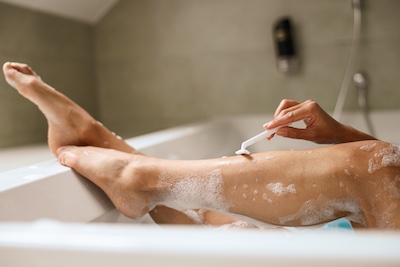Expert Tips on How to Shave

New York City dermatologist Dr. Jeremy Fenton of Schweiger Dermatology Group shares his tips on how to shave like a pro.
Shaving can be irritating. You are taking a sharp blade and dragging it across the skin! Razor burn is basically skin irritation from shaving. Razor burn isn’t dangerous, but it can create longstanding and chronic skin conditions. Razor burn is often confused with some other conditions associated with shaving. You can get ingrown hairs, including a specific type of ingrown hairs called pseudofolliculitis barbae (PB).
This is a condition in which those with curly hair have the tips of the hairs grow back into the skin. These can cause numerous red bumps on the skin, especially in the neck area. For some, the only option is to grow a short beard. One way to tell if you have razor burn or ingrown hairs is if you notice that little hairs pop out from under the skin of the bumps several days later, it was an ingrown hair. Razor burn, however, appears the same day after shaving.
The top 22 tips for a perfect shave, according to Dr. Fenton:
- Avoid using dull razors. Replace your razor blades after several uses, or whenever it feels like it is pulling the hairs and the shave doesn’t feel as smooth.
- Prep the skin: The best advice is to shave in the shower (or tub if shaving your legs) after the skin and hair has had a chance to soften from warm water and steam. I recommend shaving at the end of your shower.
- If you aren’t planning to take a shower or don’t want to get wet: let your shave gel sit for a couple minutes before shaving. Moisten the skin with warm water, put on the shave gel and then do something else like brush your teeth (which takes about the perfect amount of time) before you start shaving.
- Rinse your razor frequently between strokes with warm to hot water. Most razors have a lubricating strip, and a little warm water helps to soften that strip and release the lubricant.
- Use a shave gel instead of a shave foam. Gels are richer and do a better job of prepping the skin.
- Always shave with the grain. Never against the grain.
- More blades is not always better: There seems to be a competition amongst razor blade manufacturers to put more blades on the razors. Each additional blade produces a smaller marginal benefit, but can create more irritation. Those with sensitive skin probably want to stick to razors with 2 or 3 blades.
- Never dry shave and avoid taking a second stroke over skin AFTER the shave gel has been swiped off.
- Don’t press too hard when shaving.
- Avoid shaving with cold water or with a cold air temperature.
- If you don’t have shaving cream/gel handy, don’t use soap! Use conditioner, some argue this even works better than shave cream/gel. Soap will dry the skin out, the opposite of what you want.
- Moisturize the skin afterwards.
- You can apply an over the counter hydrocortisone cream after you shave to soothe the skin. If this isn’t sufficient, a dermatologist can prescribe something stronger. However, you can’t use a strong topical steroid on a daily basis, as it can cause side effects. Speak to your derm about this.
- Laser hair removal is always an option. I have male patients that opt for removal of the hair on the lower neck area because this is the most common culprit.
- Keep the skin well exfoliated. This makes it easier for the hairs to break through the surface of the skin. Glycolic acid and over the counter retinols (or prescription retinoids / retin-A) can also be helpful
- Avoid an overly close shave – consider using an electric razor.
- Avoiding underwear that rubs against the skin can help avoid both razor burn and ingrown hairs. Soft, 100% cotton underwear with no elastics rubbing is going to be your best choice, especially on the day you shave in the groin.
- Avoiding underwear that rubs against the skin can help avoid both razor burn and ingrown hairs. Soft, 100% cotton underwear with no elastics rubbing is going to be your best choice, especially on the day you shave in the groin.
- Never store your razor with the blades down on the counter or edge of the tub. Don’t keep it in the shower. Keep your razor in a dry place so it can dry out between uses. Sitting it in a damp environment will allow it to breed bacteria, making an infection more likely.
- Trim long hairs before shaving close. If it’s been a while, take scissors or clippers to trim the hairs down first. Long hairs will clog the razor blade.
- Exfoliate before shaving: this can prevent the dead skin cells from clogging up the blade and allow for a closer shave. The exfoliated skin will also help reduce the risk of ingrown hairs as mentioned above.
Interested in coming to Schweiger Dermatology Group? Call 844-DERM-DOC or Schedule an appointment.
Schweiger Dermatology Group is the leading provider of dermatology services in New York and New Jersey specializing in cosmetic and medical dermatology. With over 160 offices and more than 600 healthcare providers, our group of top dermatologists in NYC and the surrounding metro area are highly sought after for their expertise in treatments of acne, Botox, fillers, laser treatments, skin cancer, eczema, psoriasis and rosacea.
